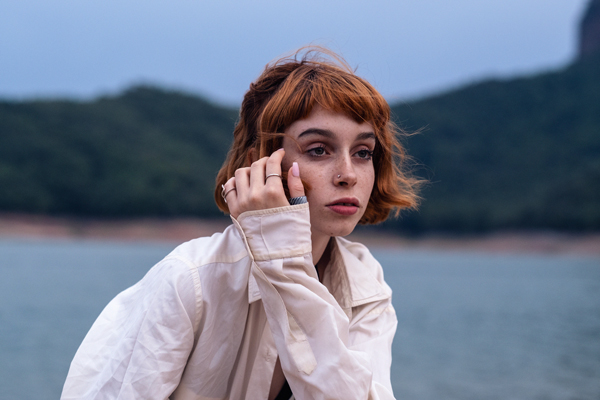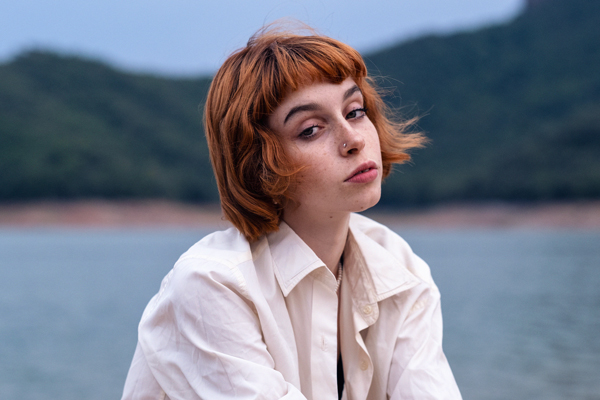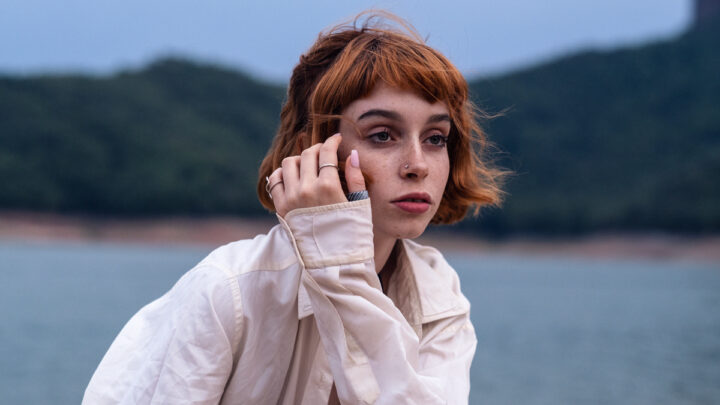Making a portrait the photographer tries to portrays a human subject capturing its essence on a photograph. Your handle of the camera, your sense of the subject, your skill using light, backgrounds and poses are very important in portrait photography.
This photographic genre can be really challenging to master, in fact it is difficult to capture a photo that looks natural and allows the subject’s personality to show through the image.
Learn how to make a photograph is about learning how to use your eyes and your brain to make a good image. It doesn’t mean learning how to use a camera. In fact nowadays everyone is able to use a camera. And cameras are becoming everyday more user friendly.
The “grammar” of photography.
The famous photographer Stephen Shore found four ways in which the world is transformed into a photograph by the camera: flatness, frame, time and focus. In his famous book “The nature of Photographs” Shore shows the distinction between formal element shared by most visual images and the grammar of photography.
Photography is inherently an analytic discipline. Where a painter starts with a blank canvas and builds a picture, a photographer starts with the messiness of the world and selects a picture […] He or she imposes this order by choosing a vantage point, choosing a frame, choosing a moment of exposure, and by selecting a plane of focus.
Stepehn Shore. The Nature of Photographs.
This four elements (flatness, frame, time and focus) define the photograph’s content and structure. These attributes are the visual grammar of photography. Through these elements the photographers express their sense of the world, give articulation to the meaning of their images.
- Flatness: the photographs are two dimensional, so the tridimensional world is captured in a flat surface. Things that are separate in the reality can be brought into relationship easily when flattered in a picture.
- Frame: a photograph, differently from reality has edges. The content in a image is contained by and in relationship with the surrounding edges.
- Time: the flow of time in the world is frozen by a photograph. The image contain just a fraction of time like a little grain of sand.
- Focus: a photograph can have a shallow or a deep plane of focus. Focus helps the photographer draw the attention to the main subject of the photograph.


According to Wikipedia: “A portrait is a painting, photograph, sculpture, or other artistic representation of a person, in which the face and its expressions are predominant, though in a full-length one the body will take up more space. The intent is to display the likeness, personality, and even the mood of the person.“
Different kind of portrait photography you can try:
- Traditional portraits: making a tradition portrait you try to capture the emotions and the expressions of your subject. You can make it in a studio or outside, using natural light or artificial light. The traditional portrait usually focus its attention on the face and the shoulders of the subject rather than the whole body.
- Lifestile portraits: this kind of portrait is often used by influencer and brands trying to inspire people to buy the outfit the subject is wearing in the photograph. The subject of the image seems portray in his/her everyday life, and really often the image is unedited or may also be taken with a mobile phone.
- Glamour portraits: differently from lifestyle portraits glamour portraits are made in a more professional way. The main intent is to enhance the beauty of the subject with a sensual vibe on it. The glamour portraits are usually made with great attention to the quality of the images.
- Conceptual portraits: these portraits try to capture an idea or a concept through the images. This kind of portraits are usually ambiguous and mysterious. Also the editing is used to achieve this result to give a surreal mood to the images captured.
- Self portraits: if interested in self portrait and selfie you can go to this blog post about self portrait photography.
- Candid portraits: when you are making candid portrait usually the subject is unaware of being photographed. Candid portraits are really interesting because through the images you can see the real emotions of the subjects portrayed in the photographs. This portrait genre is mainly used in street photography.
- Close-up portraits: the subject is captured in a very close up framing. For example capturing just the eyes or the mouth. This kind of portraits can be really powerful, just try and you won’t be disappointed by the mood of the image.
- Environmental portraits: in these kind of portraits you are capturing your subject in an environment that is important for him/her. In some way there is a relationship between the background and the subject. In fact the background helps the photographer to say something about the subject of the photograph. This kind of portrait helps the photographer practice storytelling in his/her images.
- Groups portraits: making group portraits the photographer is making images of couple or family. As there are more subjects in the image interacting with each other, group portraits are usually challenging for the photographer. It is a little bit more difficult to have a good result with more people in the photograph.
- Pet portraits: with the social media these kind of portraits are becoming more popular as pet owners love to share the portraits of their beloved pets.
What make a photographer a good portrait photographer?
Making a portrait, as a photographer, you are trying to capture in the image the essence of your subject. Anyway photography is not about the truth, photography is an interpretation. Photography is the expression of the way the photographer is seeing the reality in front of the camera. A moment captured just freezing a grain of sand in the time flowing.
All the photographs are accurate, none of them is truth.
richard avedon
So a photograph is just an interpretation, an image is not the truth. And a portrait, like every photograph, is just a capture in a certain amount of time. For example maybe your subject is a sad person but in your portrait appears completely happy the day you made it. Your image will be just an interpretation of reality, the way you see your subject that can look in a certain way in certain moment. Again: no truth, just interpretation.
This is why in a portrait the connection between the subject and the photographer is really important, this connection may helps evoke authentic emotion in the images. The photographer is a storyteller, and to tell stories he needs to have something to say.
Connect with your subject.
Try to be a compassionate, thoughtful photographer, this will make a great difference in your work. It will be very helpful connect to your subject of the portrait to obtain better result. While making a portrait try to really care about your subject and go beyond the everyday.
The main purpose of a good portrait photographer is to show the person behind the mask, to make images emotionally impactful.
Sometimes a good idea is to try to find the way to shoot how interesting can be the mundane. In fact the main target of art is to represent the human predicament, so does portrait photography as well.
The gear vs the connection with your subject.
You should always remember that is the photographer and not the camera the instrument that make a good photograph. A photographer should always care more about the subject before the gear. Again try to be thoughtful and compassionate with the subject, it is more important than buying the last camera with more megapixel. There are times that the camera becomes more important and interesting than the moment. When it happens it is better to take the camera down and focus on the moment before continuing to make photographs.
To take a photograph is to participate in another person’s (or thing’s) mortality, vulnerability, mutability. Precisely by slicing out this moment and freezing it, all photographs testify to time relentless melt.
susan sontag
The great secret of Portrait Photography.
If you are careful with people and connect with them they will offer part of themselves to be portrayed in amazing images. This is the great secret about street photography. Elliot Erwitt the renowned Magnum photographer was really aware of the importance of the subject to have a good result in his images.
It is not the subject, it’s how you treat the subject.
Elliot Erwitt
This will really impact how good your photo will be. There are two different ways to intend “the way you treat the subject”: the way you behave with the subject, and the way you “treat” the subject artistically.
Don’t shoot what it looks like. Show what it feels like.
david alan harvey
Gear is not so important in the creative process. The most important things to make a good image are ideas, light, composition, the connection with the subject of the image, the background, the camera settings, a story to tell through the image, the depth of field. If you make the image with a Canon or a Sony doesn’t make a big difference. If you make the image with a full frame or with a crop sensor doesn’t make a big difference as well.
If you have a story to tell, and know how to express your feeling and intentions you can achieve an amazing result even with an old cheap camera. The fancy new camera can’t do the work for you.
I have virtually no interest in equipment – period. It’s not what motivates me. I don’t want to talk about gear. Any camera on sale today will give you wonderful results.
Steve McCurry
What you can do through the camera settings.
Anyway portrait photography relies on your handle of the camera. At the same time your sense of the subject, your skills using lightning, backgrounds and poses are very important. With your camera you have a lot of (creative) freedom.
For example you can adjust the exposure to modify the light. And the light is everything: can completely change the mood and the feeling that your photograph is going to express.
In the same way you can change the shutter speed depending if your subject is moving or staying still. Or if you want give sense of movement through your image.
Or you can adjust the depth of field to increase the focus on the face and blur a distracting background.
Five tips to improve your Portrait Photography:
- Prepare your subject for the session: it is really important to put your subject at ease. This will make the difference between a good and a bad result. As just said above, this is more important than buying an expensive camera equipment. In fact being photographed can be really stressful and unnatural. A relaxed and comfortable subject will help achieve the best portrait you can. As a photographer you should help your model have stress-free and fun experience. Try to small talk and explain the result you want to obtain. Also try to be open to suggestions from your subject.
- Choose the right background for your subject: the background is just as important as the subject. You should figure out where you want your subject to be in your photograph. The location of your photoshoot is the setting of your portrait and draw the attention to the subject. A neutral background will help not distract the viewer from your subject. In the opposite way a distracting background will take away the attention from your main subject.
- Use the right lens: a 50mm is a standard length that most of portrait photographers like to use for portraiture. You can also try to use a longer lens, from 85mm to 200mm range. In this way you can produce image compression, bringing the background closer to the subject, increasing the bokeh, creating a dreamy mood in your photo. Or maybe you can also try something completely different using a 35mm or a 24mm focal length to have a more environmental portrait.
- Use the rule of thirds: this rule is probably the most important rule about composition. Take an image and trace two equidistant lines (both horizontal and vertical). The result will be something similar a chessboard on top of the image, composed by nine panels. This rule describes the points where the lines intersect as the points where the human eye puts the most attention.
- Try to shoot in Aperture Priority: in fact Manual Mode let you control the camera completely. But really often, like in portraiture, is better to work quickly without missing any important shoot. Aperture priority will allows you to work faster as you simply choose the aperture you want and the camera will set the proper shutter speed. Thanks to Aperture Priority Mode you can think more easily about the depth of field you want to achieve in your photo. And will be also easier to separate your subject from the background or let everything on focus if this is the result you want for your photograph.
